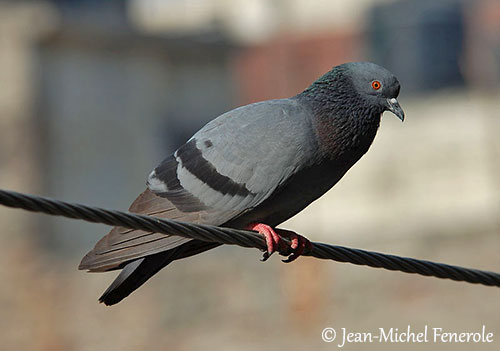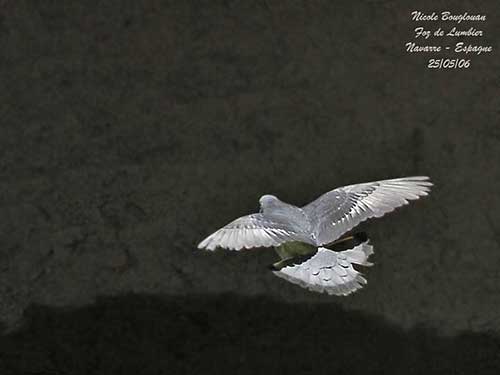
Fr: Pigeon biset
Ang: Rock Dove – Rock Pigeon
All: Felsentaube
Esp: Paloma Bravía
Ita: Piccione selvatico
Nd: Rotsduif
Sd: klippduva
Photographers:
John Anderson
John Anderson Photo Galleries
Jean Michel Fenerole
Photos d’Oiseaux du monde
Tom Grey
Tom Grey's Bird Pictures & Tom Grey's Bird Pictures 2
Alan & Ann Tate
AA Bird Photography
Nicole Bouglouan
Photographic ramble
Text by Nicole Bouglouan
Sources:
HANDBOOK OF THE BIRDS OF THE WORLD vol 4 by Josep del Hoyo-Andrew Elliott-Jordi Sargatal - Lynx Edicions - ISBN: 8487334229
PIGEONS AND DOVES by David Gibbs, Eustace Barnes and John Cox - Pica Press Sussex - ISBN: 1873403607
Animal Diversity Web (University of Michigan Museum of Zoology)
Bird Web (Seattle Audubon Society)
Birds in backyards (Birds Australia and Australian Museum)
What Bird-The ultimate Bird Guide (Mitchell Waite)
Wikipedia, the free encyclopaedia
Rock Dove or Rock Pigeon
Columba livia
Columbiformes Order – Columbidae Family
INTRODUCTION:
The wild Rock Dove or Rock Pigeon is known for nesting on sea-cliffs, in caves, rock crevices and cliff ledges, and this habit probably gives the bird its name.
It was originally found in Europe, North Africa and Western Asia, but numerous feral populations are now living in cities throughout the world.
The wild Rock Dove or Rock Pigeon shows the usual pale blue-grey plumage with two black wingbars, whereas domestic and feral birds show various colours and plumage pattern.
It feeds mainly on seeds, fruits, leaves and buds, but it is omnivorous. During the breeding season, the male performs the typical courtship displays of Columbidae, but this species nests on cliff ledges or in rock crevices on coastal cliff faces, and sometimes in buildings, especially the feral birds.
The Rock Dove has been introduced in North America in the 17th century (1603-1607) and in Australia in the 1870s. The species is also present in New Zealand where it was introduced for aviculture and racing.
The Rock Dove has large populations and the species is not globally threatened. However, urban and rural populations are sometimes reduced by humans, using trapping and poisoning baits to maintain lower numbers and reduce the use of buildings by these numerous birds.

DESCRIPTION OF THE BIRD:
Biometrics:
Length: M: 31-36 cm – F: 29-35 cm
Wingspan: 63-70 cm
Weight: M: 370g – F: 340g
The wild Rock Dove adult male is a compact bird with long wings and fairly short tail.
On the upperparts, mantle and wing-coverts are pale blue-grey but the lower back is greyish-white. On the upperwing, we can see two black wingbars on greater coverts and secondaries. The flight-feathers are darker. Rump to uppertail coverts are dark grey. The tail is dark grey with broad, blackish terminal band.
On the pale grey underparts, the chin is dark whereas the dark grey throat shows green-purple gloss. The breast is similar to the throat, but with stronger gloss. This part is bordered with sooty-grey below. Belly and undertail-coverts are blue-grey. The underside of the tail is blackish, with paler bases to outer rectrices. Axillaries and underwing-coverts are white but mostly pale grey on the leading edge.

The head is darker, plumbeous-grey but the neck shows strong glossy green-purple iridescence.
The bill is greyish-black with white cere. The eyes are golden orange to red orange, surrounded by bare, pale blue-grey eyering. Legs and feet are red to purple-red.
The female is similar but slightly smaller with duller grey plumage and less iridescence on the neck.
The juvenile is duller too, including eyes and feet. The young male may show some iridescence on the neck sides.
SUBSPECIES AND RANGE:
The Rock Dove has 12 subspecies, some of which may be derived from feral populations. The races differ in size, shade of grey on body plumage and back’s colour.
C.l. livia (described above) is found in W Palearctic in W and S Europe, N Africa from Morocco to NW Egypt, E to S Urals, W Kazakhstan, N Caucasus, Georgia, Cyprus, Turkey and Iraq.

C.l. atlantis is found in Madeira, Azores and Cape Verde Islands.
This race shows “chequered” upperparts almost concealing the dark wingbars. Many birds show an extended amount of chestnut tinge, and probably derive from feral domestic pigeons.
C.l. canariensis is found on Canary Islands and some islands off Morocco.
This one is smaller than nominate and rather darker with usually grey back.

C.l. gymnocyclus occurs in Senegal and Guinea to Ghana and Nigeria.
This race is smaller and much darker than nominate. The iridescence of the neck extends up onto the nape and the hind crown, and is more intense on throat and ear-coverts. The orbital skin is bright scarlet and broader than in nominate.
C.l. targia is found in the mountains of the Sahara, E to Sudan.
It is smaller than nominate with darker mantle and back.
C.l. dakhlae is found in WC Egypt in Dakhla and Kharga Oases.
It is smaller and much paler than nominate, with the back extensively white and pale grey uppertail-coverts. The underparts are pale grey.
C.l. shimperi occurs in Nile Delta and Nile Valley in Egypt, S to N Sudan.
It is very similar to C.l. targia, but with paler mantle, darker rump and uppertail-coverts.
C.l. paleastinae is found in Syria to Sinai, and in Arabia to Aden and Oman.
It differs from the previous by larger size and darker plumage.
C.l. gaddi occurs in Azerbaijan, Iran, W and N Afghanistan, Turkmenistan and Uzbekistan.
It is very similar to the previous but it is larger and often with paler back.
C.l. neglecta is found in Central Asian Mountains.
It is darker than nominate with stronger iridescent gloss on neck and hindneck.
C.l. intermedia occurs in Peninsular India and Sri Lanka.
It resembles “neglecta” but it is darker in the southern part of the range.

C.l. nigricans is found in Mongolia and N China, S to Shanxi and Gansu.
This one tends to be rather variable and probably derives from feral domestic stocks.
HABITAT:
The wild Rock Dove usually lives on rock faces where it nests. However, depending on the range, it can be found in caves and sea-cliffs, especially in Scotland. Other populations invade old ruined buildings. It is also found on steep rocky slopes and in canyons. It usually avoids the densely vegetated areas.
The feral populations tend to nest in buildings, skyscrapers (used as cliff substitutes), under bridges and in urban parks in cities, even with high human densities.
The species occurs from sea-level up to 4,270 metres of elevation in the Himalayas.

CALLS AND SONGS: SOUNDS BY XENO-CANTO
The Rock Dove gives a moaning “oh-oo-oor” as advertising call and at nest. The pitch is slightly rising in the middle.
During the displays, it gives bubbling “oo-roo-coo” at 1 second intervals.
When alarmed or threatened, it produces a grunted “oorhh”.
Males are usually more vocal than females which sometimes produce a shorter form of the display call.
The feral pigeons are heard all year round, with peak in spring and summer.

BEHAVIOUR IN THE WILD:
The Rock Dove feeds mainly on seeds of cereals and many other plants, green leaves, buds and fruits, rarely invertebrates.
It forages on the ground by walking while moving rapidly the head back and forth.
The feral pigeons eat food left by humans such as bread crumbs and others.

The wild Rock Dove is often seen in pairs during the breeding season. They can be gregarious when roosting or flying out to the feeding grounds. The wild birds are mainly seen in small groups, although large numbers may occur in good feeding area.
On the other hand, the feral populations are usually more gregarious and can form huge flocks of several thousands.

At the beginning of the breeding season, the male performs typical courtship displays involving the typical bowing display during which the male inflates the neck while raising the feathers of neck and rump, the head is raised but the bill is pointed down while the spread tail is lowered. It bows low while calling before to lift the head and turn away.
It may also run around the female while bowing. It also performs flight displays. It flies out from the cliff with clapping wings and then, it glides with the tail slightly spread and the wings held in deep V.

The Rock Dove breeds throughout the year and the pair is monogamous. They nest in a loose structure placed on cliff ledge or in cave or rock crevice.
They are colonial breeders and the colonies may contain up to 1,000 birds.
The Rock Dove is a sedentary, non-migratory species. Some local movements are observed in seasonally arid regions towards more suitable areas.
The flight is fast and direct with steady wingbeats. These birds may travel several kilometres between their roost and the foraging areas.

REPRODUCTION OF THIS SPECIES:
The Rock Dove breeds all year round, although in the northern part of the range, it breeds mainly from April to July, and sometimes again in August-September.
The nest-site is selected by the male, usually on cliff ledge or in a cave or rocky crevice in montane or coastal cliffs.

The feral pigeons nest on man-made structures resembling natural cliffs such as ledges on buildings or skyscrapers, under bridges or on quarry walls.

The female builds the nest but the male brings nesting material. The nest is a loose platform of twigs, roots and leaves or grass, usually with no true lining. The nest-site is reused repeatedly and the birds add nest material for each new brood.
The female lays two white eggs, and both adults share the incubation during 16-19 days. The chicks are fed with “crop milk”, a food high in fat and proteins. It is gradually replaced by seeds.
The young leave the nest about 35-37 days after hatching, but between 25 and 32 days in summer. They usually return to the nest for roosting during the first days.

PROTECTION / THREATS / STATUS:
The Rock Dove’s natural populations are affected by interbreeding with feral pigeons throughout the range, but this fact is not generally recognized as a threat to this species.
The Rock Dove is generally common but some small colonies have been submerged by the expanding feral populations. Both feral and wild birds are often found together in natural habitats, well away from towns.
The “pure” wild populations are more confined to remote cliffs and islands.
The global population was estimated to number 260,000,000 individuals in 2004.
In 2015, the European population was roughly estimated at 22,100,000/45,200,000 mature individuals.
It is suspected to be decreasing due to interbreeding with domestic pigeons. But currently, the Rock Dove is not globally threatened and the species is evaluated as Least Concern.
